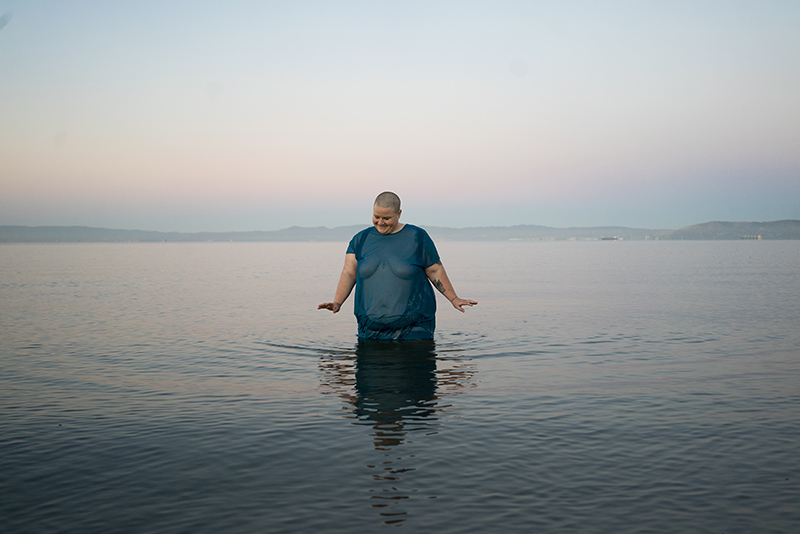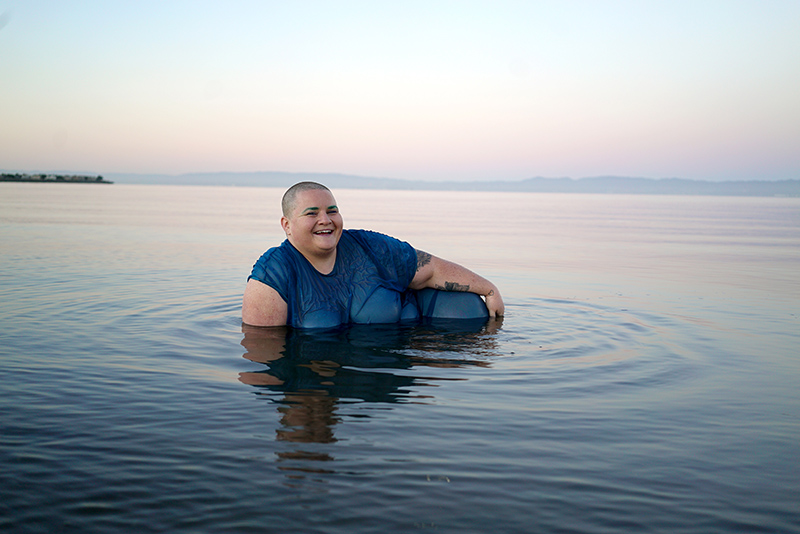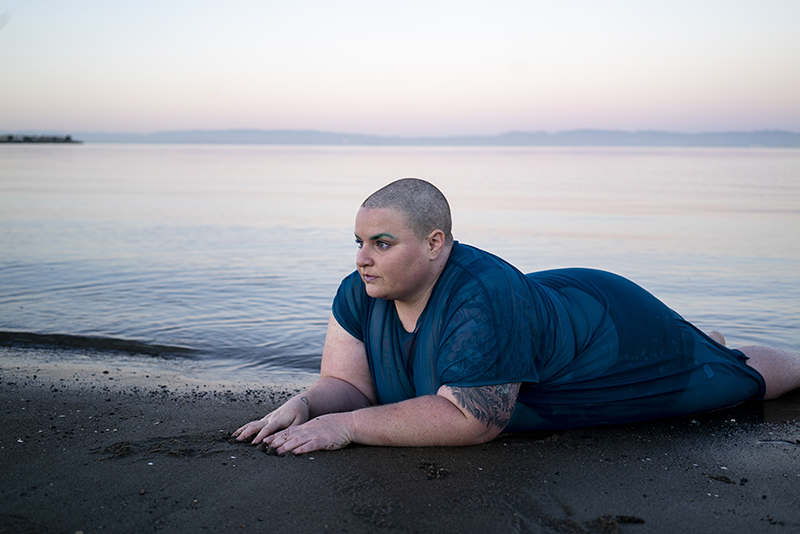Fat as Muse, Fat as Invitation
An Interview with Jules Pashall
BY EMMALY WIEDERHOLT
Photos by Chani Bockwinkel
Jules Pashall is a somatic practitioner currently based in Rhode Island who uses fat as a resource for performance and transformation. They draw upon their Master’s in Somatic Psychotherapy to offer workshops called Fat as Muse that ask participants to feel their fat and draw upon it as a source of creativity. Here, Jules shares how their fat activism and artistry overlap, how experiencing and accessing fat can be an empowering tool for self-survival, and why it’s important to address our own internalized fat phobia.
Note: This interview was first published in Stance on Dance’s fall/winter 2023 print issue. To learn more, visit stanceondance.com/print-publication.

~~
Can you share a little about your history and what shaped you as an artist and a mover?
My background is more in theater than dance. I did musical theater and singing, and then I shifted into devised theater, which incorporates movement and dance. I also shifted into burlesque. I was doing a lot of storytelling from and of the body, specifically for fat and queer people. A lot comes up when you invite people to tell stories with and from their bodies and I needed more tools for what I was inviting folks to do. I went to grad school and trained as a somatic therapist at the California Institute of Integral Studies.
When I got to school, I was coming from almost a decade of being a fat activist. I got politicized around fatness when I was 19 and started engaging with fat liberatory spaces and overlapping it with my art. My fat activism and my body-based art making were the same thing. When I got to grad school, I left a really fat positive and queer community and was suddenly around a majority of thin cis people, most of whom had never talked about fat before. While I was in school, I felt the need to take on talking about fat in a different way by doing a lot of interventions to bring fat into the conversations we were having around bodies. Most spaces where we focus on the body have ramped up anti-fatness. People also ignore fat as a part of the body when exploring or creating with the body.
How would you describe somatic therapy to someone unfamiliar with it?
I want to clarify I’m not a licensed therapist, as I did not pursue licensure, but I do have a master’s degree in it. Somatic therapy is a big umbrella term for lots of different modalities and practices, but its main difference from traditional talk-based therapy is that it focuses on centering the body. It’s a term for many “body-up” approaches.
How did you get involved in fat activism?
Necessity. I’ve been fat my whole life. I grew up in the 90s in an affluent white suburb of Boston where I had an understanding that fat was not okay. I got a lot of education around the idea that people don’t deserve to be treated badly for who they are and their identities, but it never occurred to me that fat was included in that framework. When I went to college, I read this book my freshman year called The Cult of Thinness by Sharlene Hesse-Biber and it blew my mind. It was the first time I was given a framework to think about the way people treated me for my size as something systemic. Like, “I don’t deserve to be treated like shit because I’m fat?! Anti-fatness is systemic and bigger than me?!” Growing up, fat felt like a personal failing. The thinking was “If you wanted to not be treated badly, you could just lose weight. Since you can’t lose weight, you deserve to be treated badly.” When I was 19 and read that book, a switch flipped: anti-fatness was bigger than me and how people treat me.
After that, all my papers and my performance art were about being fat. But it wasn’t until after college when I moved to Texas that I connected with other fat and queer people. It was powerful because I wasn’t having to educate people about my existence because there was enough shared experience. I became part of a radical group of queer people who were doing work on anti-racism, trans misogyny and trans phobia within the queer community, and cultural appropriation in the drag community. Fatness wasn’t separate. Fat queer trans disabled people of color were organizing and making a lot of art.
How would you describe your current artistic practice?
Right now, I’m invested in inviting people to engage with their fat creatively through dance, somatics, and theater. I am asking the question, “How do we tap into fat as part of the body that we make and create from and with?” That has looked a lot of different ways. Lately, I’ve been teaching a workshop called Fat as Muse that asks folks to engage with their fat as a source of creative material. I’ve been teaching that online and in dance spaces and non-dance spaces. Most of us outside the dance and somatics world haven’t been asked to feel our bodies, period, much less asked to feel our fat.
I also do one-on-one somatic support with folks. Because of the pandemic, most of my work is online. That’s been most accessible to folks, but I also travel to teach workshops.
How does your activism inform your artistic practice and vice versa?
In all the art I’ve ever made, my fat body is very central. The art I’ve made is always about my fatness and inviting fat people to make art about their bodies too.

How do your fat identity and your queer identity inform one another?
Coming into fat identity made space for me to come into queer identity by allowing me to process my trauma around desirability and body autonomy. The more space I make, the more gets discovered: I’m fat, I’m queer, I’m non-binary, I’m trans. It keeps opening. There’s this way in which the more I let myself emerge, the more I’m just telling the truth about what’s always been there.
Have you seen a similar unfolding with folks you’ve worked with?
Absolutely. When someone feels their fat, it invites them to have more sensation and awareness of parts of their body they often haven’t spent much time feeling. Or if they have felt their fat, oftentimes it’s with judgements around it being either bad or good. When I work with folks, I am inviting them to feel their fat with open curiosity, respect, and care. This kind of invitation opens a lot: memory, ancestral stuff, childhood stuff. We get detached from feeling our fat so when you are given the instruction to bring your attention to it, a lot can emerge that hasn’t been given space before.
I don’t prescribe that people have to feel and be positive about their fat. Fat, like every part of life on this earth, is complex and nuanced and deserving of space to be many things at once. My work is centered on reminding people that fat is on everyone of any size, period. Most of your brain is fat. It’s also in your bone marrow. There are so many layers to the invitation to feel your fat.
Oppressive systems thrive on disconnecting us from our bodies. Fat hatred, as it is linked and embedded with all other systems of oppression, is one tactic for disconnecting us from feeling our bodies. My agenda is to invite people to feel their fat so they can feel more of their bodies and access more of what we need to care for each other and survive. Accessing fat is one way to access what we might need to survive. I try not to get too grandiose about it, but that’s at the heart of it.
What are some steps that professional and educational arts institutions can take to make their spaces more welcoming to fat people?
The biggest piece that is foundational is tending your relationship with your own body and fat. So often I hear from folks that they’re totally on board with unpacking fat phobia. They see that it is wrong when they witness it outside of themselves, but struggle very much to internalize that: “Everyone else should totally be more loving towards their bodies, but not me.” I believe that if we don’t tend to our own relationships with our bodies and our fat, we can’t fully do that for others. It will seep out onto others eventually. If you are inviting fat people to work with you but you have not unpacked how you have internalized fat hatred, it will be felt. I trust people who work in the field of dance and the arts to understand that most of our feelings, beliefs, and thoughts are expressed nonverbally. If you are holding onto feelings about fat people or your own body and fat, it will be felt.
This is not a destination; it is ongoing and forever work for most of us. We keep tending it.

~~
Follow Jules on Instagram @fat.as.the.sea.
